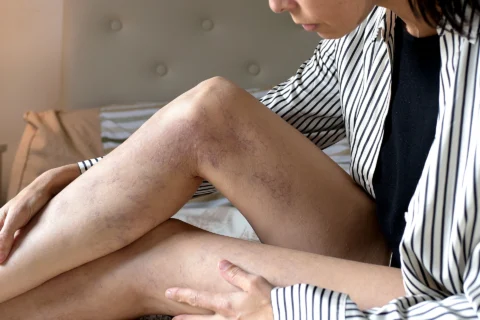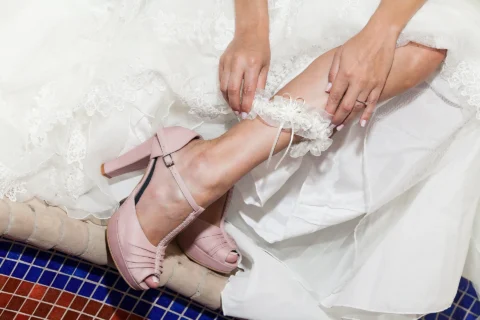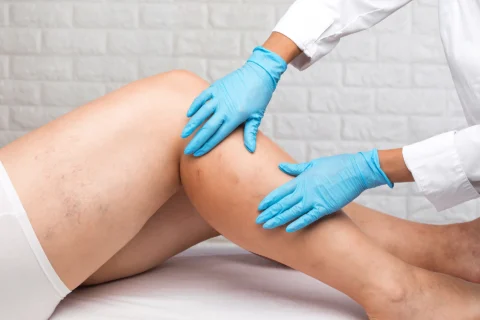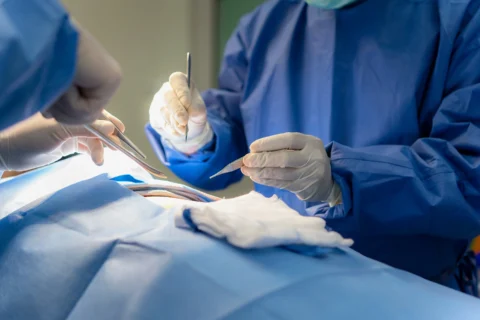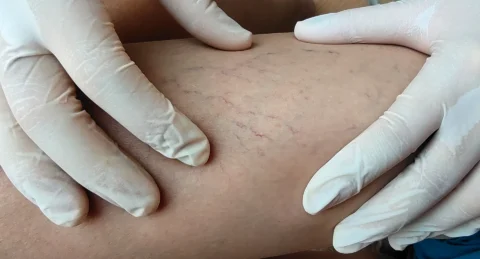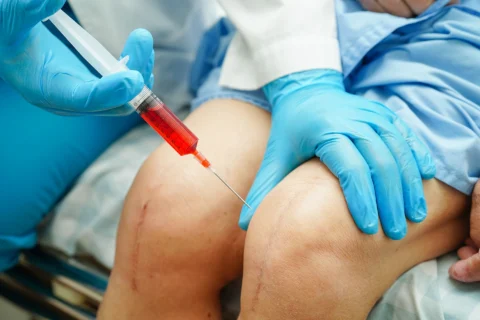Varicose veins are a kind of chronic venous disease, which are characterized as enlarged vein areas that unpleasantly show on the skin surface. This is a result of venous reflux, which may also be accompanied by mild pain or discomfort that could feel heavy in the legs. Sometimes, the pain is felt regardless of whether or not you’re touching your skin – especially near the ankles.
So why do varicose veins near the ankles hurt when you touch your skin in that area? The reason why varicose veins may hurt where it’s located is because of the inflammation that occurs in the area. In most cases, this isn’t considered an emergency; however, it’s best to consult with a vein specialist to get the right kind of treatment for it.
Do Varicose Veins Near Ankles Hurt When You Touch Your Skin: What Does It Indicate?
Varicose veins (i.e, venous insufficiency) are enlarged, swollen, saphenous vein areas that usually occur on the legs, but they may also be found on the ankles. The abnormal veins are usually colored blue or dark purple, which may also appear twisted or bulging. Pain and discomfort are usually symptoms that accompany varicose veins, and sometimes it’s even more painful when you touch your skin.
The leg pain associated with varicose veins is usually due to inflammation of the affected vein area. Because of the stretched vein and skin area, a patient experiences varicose vein pain when they come in contact with their skin.
In some cases, painful varicose veins are a sign of blood clots in the area, open sores, or skin infection. There are instances when it’s more than just a simple inflammation caused by varicose veins; it can also be a case of phlebitis.
Explaining Varicose Veins: Why It Hurts When Varicose Veins Near Ankles Touch Your Skin
Varicose veins are characterized by an enlarged saphenous vein area, which is twisted and bulging. In some cases, the inflammation caused by varicose veins can cause vein pain and skin irritation, which can further block regular blood flow in the veins. Such a case is also known as phlebitis.
Phlebitis (i.e, thrombophlebitis) is basically a vein inflammation caused by multiple blood clots in the vein. This can occur in a superficial vein or deep vein. When superficial thrombophlebitis occurs in a superficial vein, it’s not usually a serious condition, although proper medical care is still required.
However, when these blood clots and inflammation gets deep and affects the larger blood vessel, then it becomes a serious medical condition in need of immediate medical attention. The causes of phlebitis is similar to the causes of varicose veins. It’s important to take note of the risk factors to avoid experiencing varicose veins and the pain associated with its inflammation. Such risk factors include the following:
- Long periods of inactivity and having sedentary lifestyle
- Obesity or excessive weight
- Continuous cigarette use
- Blood disorders
- Arm or leg injury
- Hormone therapy
- Birth control pills
- Pregnancy
The Dangers of Non-Treatment of Painful Varicose Veins
Pain is always a sign that something needs repair or maintenance in your body, so painful varicose veins may also be hinting at a serious medical problem that needs to be addressed as soon as possible. If chronic venous insufficiency is not treated, it can result in the following:
- Edema. Edema or swelling occurs when pressure builds up within the diseased vein, which can cause fluids from the blood to leak into the surrounding tissues of the vein wall. This tight sensation in the skin may lead to skin discoloration or hardening of the skin area.
- Leg Ulcer and Venous Ulcer. The swelling caused by varicose veins can cause skin changes, which also interferes with the skin’s capacity to heal faster. The tension caused by the swelling in the skin restricts the sufficient flow of nutrients and oxygen into the affected tissue, which then creates an environment that fosters non-healing skin ulcers.
- Skin Infection. One of the skin changes caused by varicose veins is the skin’s vulnerability to infections, particularly cellulitis. The skin already has bacteria that are normally present in it, and when varicose veins occur, the skin becomes more vulnerable to these kinds of bacteria.
- Uncontrolled Bleeding. When painful varicose veins occur, it may be a sign of possible significant bleeding. In this case, the skin may be broken or if not, then a very visible bruise would appear in the skin. The injury caused in this case would be unusual and it may take longer for the body to heal from it.
- Thrombophlebitis. Phlebitis is an inflammation caused by a blood clot, which may be causing pain, or varicose veins may lead to such a condition if the pain experienced from it remains unresolved.
- Deep Vein Thrombosis. An even more amplified version of thrombophlebitis is deep vein thrombosis, which is a kind of blood clot that develops into deep veins. If unresolved, a patient may be at risk for an extremely serious life-threatening medical condition called pulmonary embolism.
High-Quality Treatment Recommendations for Varicose Veins

If you’re experiencing pain in your varicose veins, then it’s best to consult with a vein specialist who knows how to trace a vein problem from its root cause. The good news is that you don’t always have to go through surgical means just to treat your varicose veins and the pain it causes. There are many non-invasive treatment options available to resolve it while keeping your recovery period and downtime short, such as the following:
1) Sclerotherapy
Sclerotherapy involves the use of a catheter that directly injects a special solution into the affected veins. This is a popular venous disease treatment for spider veins and varicose veins, which eliminates the old, damaged vein and redirects blood flow into healthy veins in the body.
2) VenaSeal
VenaSeal is a process that uses an FDA-approved adhesive that acts as a vein glue. This procedure requires no anesthesia. Similar to sclerotherapy, this vein disease treatment results in a closed and eliminated affected vein, which is eventually reabsorbed into the body.
3) Radiofrequency Ablation
Radiofrequency Ablation (RFA) uses radiofrequency to ablate abnormal veins, which forms a scar tissue from the sealed damaged diseased vein. The body then reabsorbs the scar tissue from the ablated vein and redirects blood flow into healthy veins.
4) Venous Compression Therapy
Compression therapy uses physical therapy or home remedy options to help facilitate a faster recovery process. This allows the body to absorb the scar tissue quickly and see results immediately.
This treatment option uses medical devices such as compression bandage, compression socks, and compression stockings. Depending on a vein specialist’s recommendation, a patient may also be advised to use intermittent pneumatic compression devices for the compression therapy treatment option.
Best Solutions for Painful Varicose Veins at Vein Center Doctor

Painful varicose veins may be indicative of a serious medical problem. This doesn’t only occur in the ankle, as it can also be painful in the lower leg. Thankfully, a patient doesn’t have to suffer through varicose vein pain for a long time. There are many venous insufficiency treatment options for venous pain relief to restore vein health, which is available at Vein Center Doctor.
Vein Center Doctor offers holistic spider vein and varicose vein treatments using minimally invasive treatment options that are as effective or even better than surgical alternatives, so you can have your unsightly veins removed in no time. Book a consultation with us and learn more about our spider vein and varicose vein treatment options today and be free from venous pain and diseases as soon as possible.


